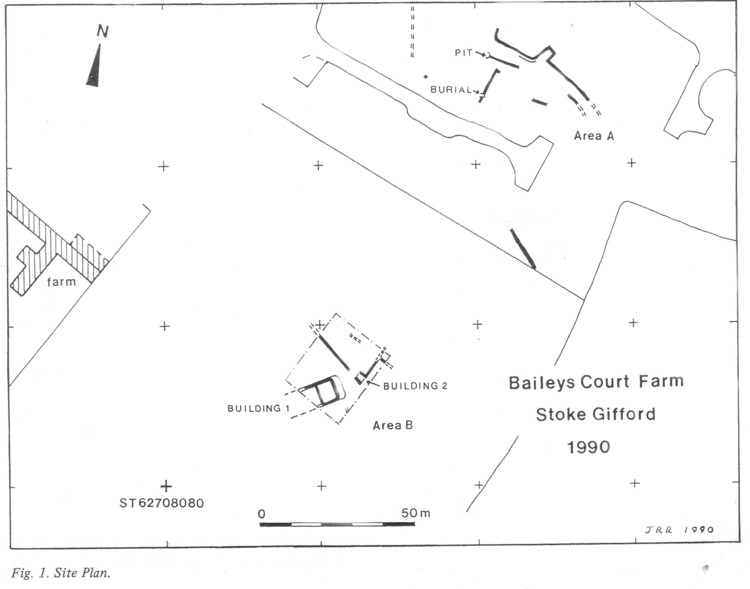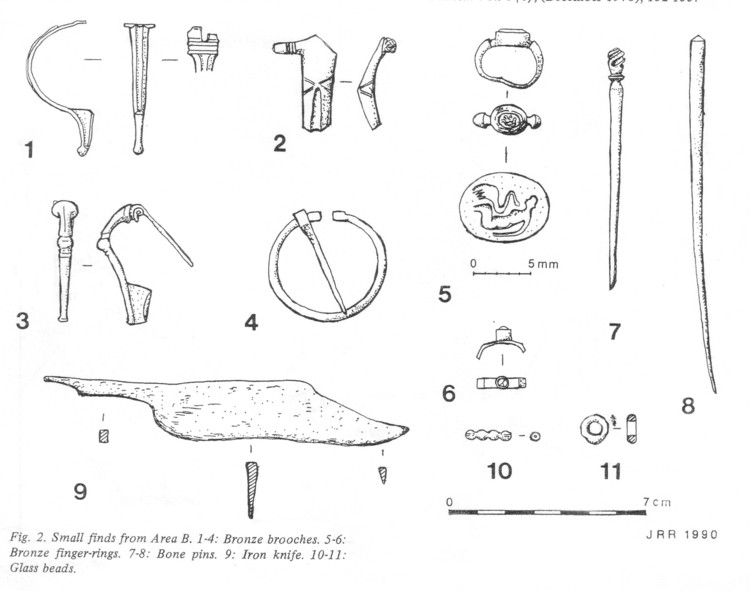Excavations at Baileys Court Farm by James Russell
(A PRELIMINARY NOTE)
Bristol & Avon Archaeology 8 pages 53, 54
Between March and June 1990 rescue excavations were carried out by BAAS and Bristol City Museum on the site of a previously unrecorded Roman settlement revealed by topsoil clearance to the east of Baileys Court Farm (now the Baileys Court Inn), Stoke Gifford. The newly‑discovered site, which lies some 1400m north‑east of another Romano‑British farmstead excavated in 1978‑1981 (ST 61708010; Parker 1978) occupies almost level ground rising gently to the east, the underlying geology comprising alternate bands of white lias limestone and yellow clay. Two separate areas of the settlement were exposed, the first (area A; ST 62828092) during building work and the second (area B; ST 62758085) during preparation of a cricket pitch. On both sites excavation, confined to the uppermost Roman deposits, was undertaken at weekends and bank holidays by BAAS volunteers under the supervision of Mr J. M. Hunt and the present writer, followed by detailed recording carried out by the Field Archaeology Section, Bristol City Museum under the direction of Mr B. Williams. Funding for the work undertaken by the Museum was generously provided by the developers, Tarmac Homes PLC (area A), Midas Construction, Hubbard Ford Partnership and Northavon District Council (area B). While new housing has now largely obliterated the remains exposed in area A, those in area B will be preserved below the new cricket square, the drainage for which has been redesigned by the developer to minimise damage.

AREA A
A complex of walls of unmortared lias limestone was uncovered, apparently
defining a series of yards or paddocks laid out on either side of an east‑west
trackway. Towards the western end of the area a north‑south wall was cut by a
shallow grave containing the extended skeleton of a child, aligned eastwest
with its head to the west. Further north an east‑west wall was cut by a large
pit of uncertain purpose, only a small part of which could be excavated.
AREA B
On the southern part of the trapezoidal area cleared for the new cricket square
the unmortared has footings of a substantial rectangular structure with rounded
corners (Building 1) were partly exposed. The north‑east. gable wall of the
building appeared to have been twice reconstructed, being moved south‑westwards
on each occasion. Within the northeast end of the structure was a room with a
well‑preserved stone floor, partly pitched and partly flagged, in which was set
an upright pottery flagon containing an unworn post-abdication follis of
Diocletian (c. 305 AD). To the southwest of this room the outer walls of the
building seem to have been demolished and robbed out before the end of the Roman
period, being overlain by a deposit of dark soil containing at least six infant
burials. To the north‑east of Building 1 further wall foundations and paved
areas appear to form part of a second structure extending beyond the edge of the
excavation. Above foundation level both buildings are likely to have been
constructed largely of timber and to have been roofed with thatch, since no clay
or stone roof tiles were recovered.
FINDS
Considerable quantities of pottery were recovered from both excavated areas,
consisting mainly of local coarse wares but including a significant amount of
plain and decorated 2nd century Samian.
Non‑ceramic small finds, of which a selection are illustrated in Fig. 2, came almost exclusively from area B. Of particular interest are a bronze signet ring with a blue glass intaglio depicting Leda and the Swan (Fig. 2.5) and a brooch of ;Aucissa; type (Fig. 2.1), normally dated to the mid Ist century AD. Other finds include spindle whorls, whetstones, iron ox‑goads and a dolomitic conglomerate quern stone. Some 30 coins, all of mid 3rd to mid 4th century date, were recovered. It is to be regretted that a significant number of coins and other metal objects were removed from the site without record by unauthorised metal detector users.
REFERENCE
Parker, AJ. 1978. The Stoke Gifford Roman Site. BARG Bulletin Vol. 6 (6),
(December 1978), 152‑155.
 |